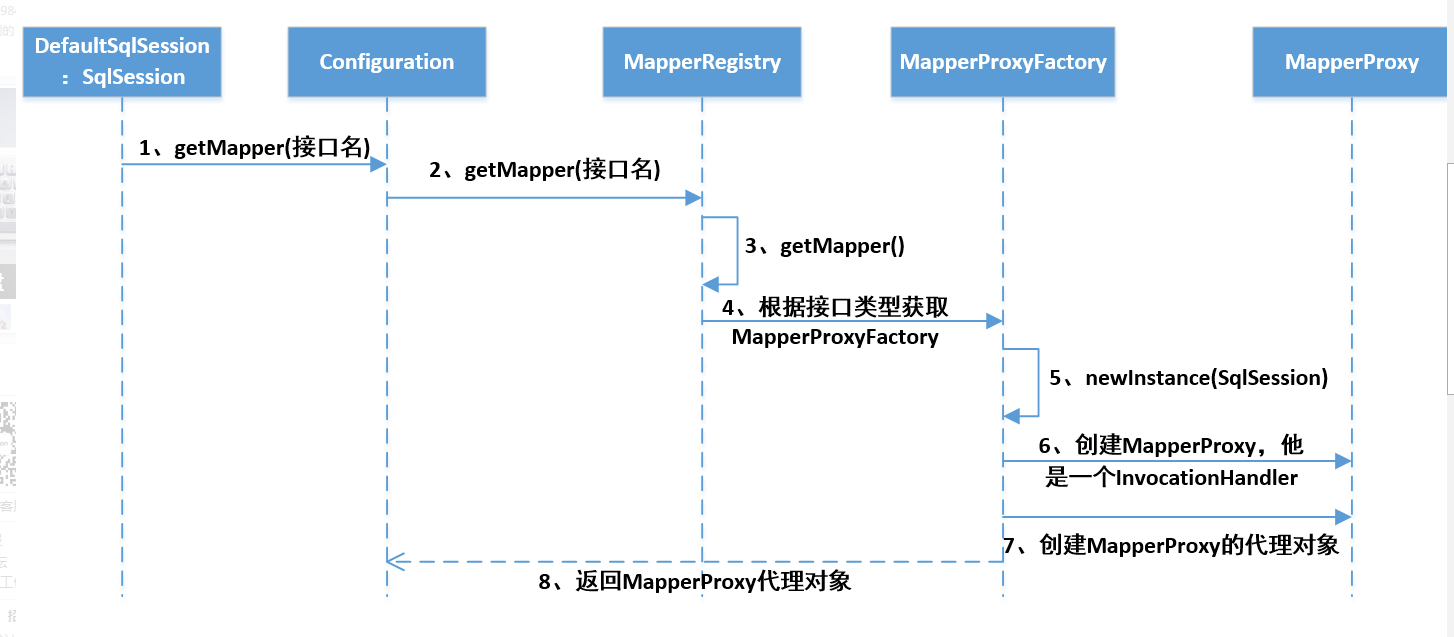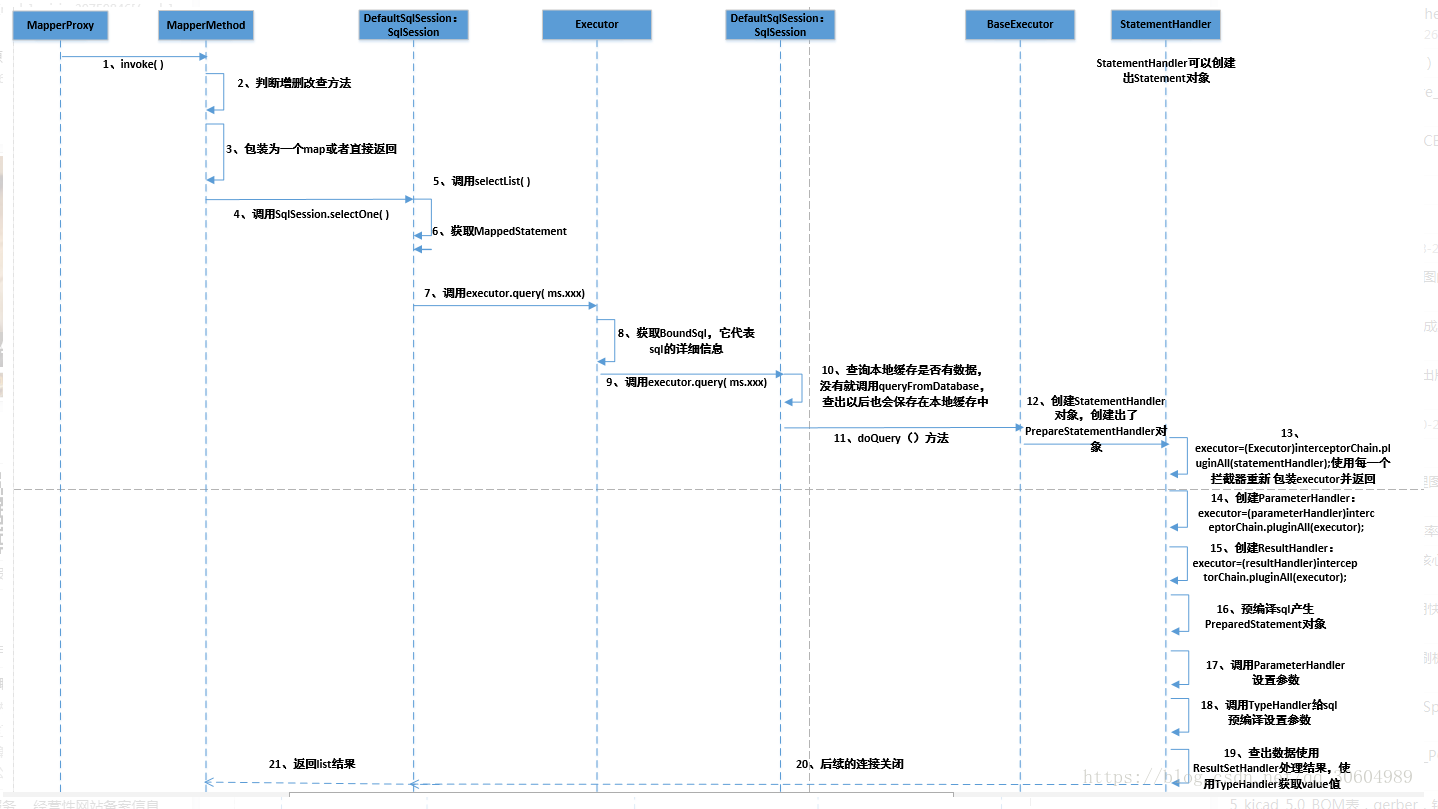MyBatis执行Sql的流程分析
本博客着重介绍MyBatis执行Sql的流程,关于在执行过程中缓存、动态SQl生成等细节不在本博客中体现,相应内容后面再单独写博客分析吧。
还是以之前的查询作为列子:
public class UserDaoTest {
private SqlSessionFactory sqlSessionFactory;
@Before
public void setUp() throws Exception{
ClassPathResource resource = new ClassPathResource("mybatis-config.xml");
InputStream inputStream = resource.getInputStream();
sqlSessionFactory = new SqlSessionFactoryBuilder().build(inputStream);
}
@Test
public void selectUserTest(){
String id = "{0003CCCA-AEA9-4A1E-A3CC-06D884BA3906}";
SqlSession sqlSession = sqlSessionFactory.openSession();
CbondissuerMapper cbondissuerMapper = sqlSession.getMapper(CbondissuerMapper.class);
Cbondissuer cbondissuer = cbondissuerMapper.selectByPrimaryKey(id);
System.out.println(cbondissuer);
sqlSession.close();
}
}
之前提到拿到sqlSession之后就能进行各种CRUD操作了,所以我们就从sqlSession.getMapper这个方法开始分析,看下整个Sql的执行流程是怎么样的。
获取Mapper的流程#
进入sqlSession.getMapper方法,会发现调的是Configration对象的getMapper方法:
public <T> T getMapper(Class<T> type, SqlSession sqlSession) {
//mapperRegistry实质上是一个Map,里面注册了启动过程中解析的各种Mapper.xml
//mapperRegistry的key是接口的Class类型
//mapperRegistry的Value是MapperProxyFactory,用于生成对应的MapperProxy(动态代理类)
return mapperRegistry.getMapper(type, sqlSession);
}
进入getMapper方法:
public <T> T getMapper(Class<T> type, SqlSession sqlSession) {
final MapperProxyFactory<T> mapperProxyFactory = (MapperProxyFactory<T>) knownMappers.get(type);
//如果配置文件中没有配置相关Mapper,直接抛异常
if (mapperProxyFactory == null) {
throw new BindingException("Type " + type + " is not known to the MapperRegistry.");
}
try {
//关键方法
return mapperProxyFactory.newInstance(sqlSession);
} catch (Exception e) {
throw new BindingException("Error getting mapper instance. Cause: " + e, e);
}
}
进入MapperProxyFactory的newInstance方法:
public class MapperProxyFactory<T> {
private final Class<T> mapperInterface;
private final Map<Method, MapperMethod> methodCache = new ConcurrentHashMap<Method, MapperMethod>();
public MapperProxyFactory(Class<T> mapperInterface) {
this.mapperInterface = mapperInterface;
}
public Class<T> getMapperInterface() {
return mapperInterface;
}
public Map<Method, MapperMethod> getMethodCache() {
return methodCache;
}
//生成Mapper接口的动态代理类MapperProxy,MapperProxy实现了InvocationHandler 接口
@SuppressWarnings("unchecked")
protected T newInstance(MapperProxy<T> mapperProxy) {
return (T) Proxy.newProxyInstance(mapperInterface.getClassLoader(), new Class[] { mapperInterface }, mapperProxy);
}
public T newInstance(SqlSession sqlSession) {
final MapperProxy<T> mapperProxy = new MapperProxy<T>(sqlSession, mapperInterface, methodCache);
return newInstance(mapperProxy);
}
}
获取Mapper的流程总结如下:
Mapper方法的执行流程#
下面是动态代理类MapperProxy,调用Mapper接口的所有方法都会先调用到这个代理类的invoke方法(注意由于Mybatis中的Mapper接口没有实现类,所以MapperProxy这个代理对象中没有委托类,也就是说MapperProxy干了代理类和委托类的事情)。好了下面重点看下invoke方法。
//MapperProxy代理类
public class MapperProxy<T> implements InvocationHandler, Serializable {
private static final long serialVersionUID = -6424540398559729838L;
private final SqlSession sqlSession;
private final Class<T> mapperInterface;
private final Map<Method, MapperMethod> methodCache;
public MapperProxy(SqlSession sqlSession, Class<T> mapperInterface, Map<Method, MapperMethod> methodCache) {
this.sqlSession = sqlSession;
this.mapperInterface = mapperInterface;
this.methodCache = methodCache;
}
@Override
public Object invoke(Object proxy, Method method, Object[] args) throws Throwable {
try {
if (Object.class.equals(method.getDeclaringClass())) {
return method.invoke(this, args);
} else if (isDefaultMethod(method)) {
return invokeDefaultMethod(proxy, method, args);
}
} catch (Throwable t) {
throw ExceptionUtil.unwrapThrowable(t);
}
//获取MapperMethod,并调用MapperMethod
final MapperMethod mapperMethod = cachedMapperMethod(method);
return mapperMethod.execute(sqlSession, args);
}
MapperProxy的invoke方法非常简单,主要干的工作就是创建MapperMethod对象或者是从缓存中获取MapperMethod对象。获取到这个对象后执行execute方法。
所以这边需要进入MapperMethod的execute方法:这个方法判断你当前执行的方式是增删改查哪一种,并通过SqlSession执行相应的操作。(这边以sqlSession.selectOne这种方式进行分析~)
public Object execute(SqlSession sqlSession, Object[] args) {
Object result;
//判断是CRUD那种方法
switch (command.getType()) {
case INSERT: {
Object param = method.convertArgsToSqlCommandParam(args);
result = rowCountResult(sqlSession.insert(command.getName(), param));
break;
}
case UPDATE: {
Object param = method.convertArgsToSqlCommandParam(args);
result = rowCountResult(sqlSession.update(command.getName(), param));
break;
}
case DELETE: {
Object param = method.convertArgsToSqlCommandParam(args);
result = rowCountResult(sqlSession.delete(command.getName(), param));
break;
}
case SELECT:
if (method.returnsVoid() && method.hasResultHandler()) {
executeWithResultHandler(sqlSession, args);
result = null;
} else if (method.returnsMany()) {
result = executeForMany(sqlSession, args);
} else if (method.returnsMap()) {
result = executeForMap(sqlSession, args);
} else if (method.returnsCursor()) {
result = executeForCursor(sqlSession, args);
} else {
Object param = method.convertArgsToSqlCommandParam(args);
result = sqlSession.selectOne(command.getName(), param);
}
break;
case FLUSH:
result = sqlSession.flushStatements();
break;
default:
throw new BindingException("Unknown execution method for: " + command.getName());
}
if (result == null && method.getReturnType().isPrimitive() && !method.returnsVoid()) {
throw new BindingException("Mapper method '" + command.getName()
+ " attempted to return null from a method with a primitive return type (" + method.getReturnType() + ").");
}
return result;
}
sqlSession.selectOne方法会会调到DefaultSqlSession的selectList方法。这个方法获取了获取了MappedStatement对象,并最终调用了Executor的query方法。
public <E> List<E> selectList(String statement, Object parameter, RowBounds rowBounds) {
try {
MappedStatement ms = configuration.getMappedStatement(statement);
return executor.query(ms, wrapCollection(parameter), rowBounds, Executor.NO_RESULT_HANDLER);
} catch (Exception e) {
throw ExceptionFactory.wrapException("Error querying database. Cause: " + e, e);
} finally {
ErrorContext.instance().reset();
}
}
然后,通过一层一层的调用(这边省略了缓存操作的环节,会在后面的文章中介绍),最终会来到doQuery方法, 这儿咱们就随便找个Excutor看看doQuery方法的实现吧,我这儿选择了SimpleExecutor:
public <E> List<E> doQuery(MappedStatement ms, Object parameter, RowBounds rowBounds, ResultHandler resultHandler, BoundSql boundSql) throws SQLException {
Statement stmt = null;
try {
Configuration configuration = ms.getConfiguration();
//内部封装了ParameterHandler和ResultSetHandler
StatementHandler handler = configuration.newStatementHandler(wrapper, ms, parameter, rowBounds, resultHandler, boundSql);
stmt = prepareStatement(handler, ms.getStatementLog());
//StatementHandler封装了Statement, 让 StatementHandler 去处理
return handler.<E>query(stmt, resultHandler);
} finally {
closeStatement(stmt);
}
}
接下来,咱们看看StatementHandler 的一个实现类 PreparedStatementHandler(这也是我们最常用的,封装的是PreparedStatement), 看看它使怎么去处理的:
public <E> List<E> query(Statement statement, ResultHandler resultHandler) throws SQLException {
//到此,原形毕露, PreparedStatement, 这个大家都已经滚瓜烂熟了吧
PreparedStatement ps = (PreparedStatement) statement;
ps.execute();
//结果交给了ResultSetHandler 去处理,处理完之后返回给客户端
return resultSetHandler.<E> handleResultSets(ps);
}
到此,整个调用流程结束。
简单总结#
这边结合获取SqlSession的流程,做下简单的总结:
- SqlSessionFactoryBuilder解析配置文件,包括属性配置、别名配置、拦截器配置、环境(数据源和事务管理器)、Mapper配置等;解析完这些配置后会生成一个Configration对象,这个对象中包含了MyBatis需要的所有配置,然后会用这个Configration对象创建一个SqlSessionFactory对象,这个对象中包含了Configration对象;
- 拿到SqlSessionFactory对象后,会调用SqlSessionFactory的openSesison方法,这个方法会创建一个Sql执行器(Executor组件中包含了Transaction对象),这个Sql执行器会代理你配置的拦截器方法。
- 获得上面的Sql执行器后,会创建一个SqlSession(默认使用DefaultSqlSession),这个SqlSession中也包含了Configration对象和上面创建的Executor对象,所以通过SqlSession也能拿到全局配置;
- 获得SqlSession对象后就能执行各种CRUD方法了。
以上是获得SqlSession的流程,下面总结下本博客中介绍的Sql的执行流程:
- 调用SqlSession的getMapper方法,获得Mapper接口的动态代理对象MapperProxy,调用Mapper接口的所有方法都会调用到MapperProxy的invoke方法(动态代理机制);
- MapperProxy的invoke方法中唯一做的就是创建一个MapperMethod对象,然后调用这个对象的execute方法,sqlSession会作为execute方法的入参;
- 往下,层层调下来会进入Executor组件(如果配置插件会对Executor进行动态代理)的query方法,这个方法中会创建一个StatementHandler对象,这个对象中同时会封装ParameterHandler和ResultSetHandler对象。调用StatementHandler预编译参数以及设置参数值,使用ParameterHandler来给sql设置参数。
Executor组件有两个直接实现类,分别是BaseExecutor和CachingExecutor。CachingExecutor静态代理了BaseExecutor。Executor组件封装了Transction组件,Transction组件中又分装了Datasource组件。
- 调用StatementHandler的增删改查方法获得结果,ResultSetHandler对结果进行封装转换,请求结束。
Executor、StatementHandler 、ParameterHandler、ResultSetHandler,Mybatis的插件会对上面的四个组件进行动态代理。
重要类#
-
MapperRegistry:本质上是一个Map,其中的key是Mapper接口的全限定名,value的MapperProxyFactory;
-
MapperProxyFactory:这个类是MapperRegistry中存的value值,在通过sqlSession获取Mapper时,其实先获取到的是这个工厂,然后通过这个工厂创建Mapper的动态代理类;
-
MapperProxy:实现了InvocationHandler接口,Mapper的动态代理接口方法的调用都会到达这个类的invoke方法;
-
MapperMethod:判断你当前执行的方式是增删改查哪一种,并通过SqlSession执行相应的操作;
-
SqlSession:作为MyBatis工作的主要顶层API,表示和数据库交互的会话,完成必要数据库增删改查功能;
-
Executor:MyBatis执行器,是MyBatis 调度的核心,负责SQL语句的生成和查询缓存的维护;
StatementHandler:封装了JDBC Statement操作,负责对JDBC statement 的操作,如设置参数、将Statement结果集转换成List集合。
ParameterHandler:负责对用户传递的参数转换成JDBC Statement 所需要的参数,
ResultSetHandler:负责将JDBC返回的ResultSet结果集对象转换成List类型的集合;
TypeHandler:负责java数据类型和jdbc数据类型之间的映射和转换
MappedStatement:MappedStatement维护了一条<select|update|delete|insert>节点的封装,
SqlSource:负责根据用户传递的parameterObject,动态地生成SQL语句,将信息封装到BoundSql对象中,并返回
BoundSql:表示动态生成的SQL语句以及相应的参数信息
Configuration:MyBatis所有的配置信息都维持在Configuration对象之中。
调试主要关注点#
- MapperProxy.invoke方法:MyBatis的所有Mapper对象都是通过动态代理生成的,任何方法的调用都会调到invoke方法,这个方法的主要功能就是创建MapperMethod对象,并放进缓存。所以调试时我们可以在这个位置打个断点,看下是否成功拿到了MapperMethod对象,并执行了execute方法。
- MapperMethod.execute方法:这个方法会判断你当前执行的方式是增删改查哪一种,并通过SqlSession执行相应的操作。Debug时也建议在此打个断点看下。
- DefaultSqlSession.selectList方法:这个方法获取了获取了MappedStatement对象,并最终调用了Executor的query方法;
参考#
作者:程序员自由之路
出处:https://www.cnblogs.com/54chensongxia/p/11850470.html
版权:本作品采用「署名-非商业性使用-相同方式共享 4.0 国际」许可协议进行许可。





【推荐】国内首个AI IDE,深度理解中文开发场景,立即下载体验Trae
【推荐】编程新体验,更懂你的AI,立即体验豆包MarsCode编程助手
【推荐】抖音旗下AI助手豆包,你的智能百科全书,全免费不限次数
【推荐】轻量又高性能的 SSH 工具 IShell:AI 加持,快人一步
· go语言实现终端里的倒计时
· 如何编写易于单元测试的代码
· 10年+ .NET Coder 心语,封装的思维:从隐藏、稳定开始理解其本质意义
· .NET Core 中如何实现缓存的预热?
· 从 HTTP 原因短语缺失研究 HTTP/2 和 HTTP/3 的设计差异
· 周边上新:园子的第一款马克杯温暖上架
· Open-Sora 2.0 重磅开源!
· 分享 3 个 .NET 开源的文件压缩处理库,助力快速实现文件压缩解压功能!
· Ollama——大语言模型本地部署的极速利器
· DeepSeek如何颠覆传统软件测试?测试工程师会被淘汰吗?